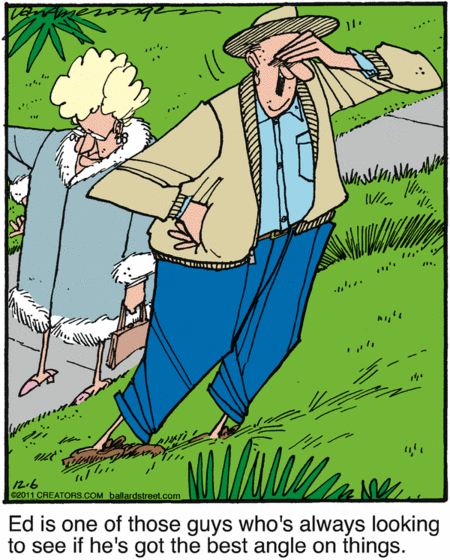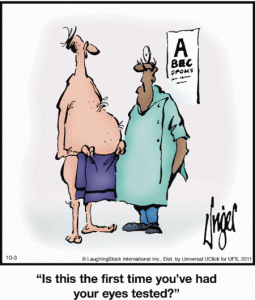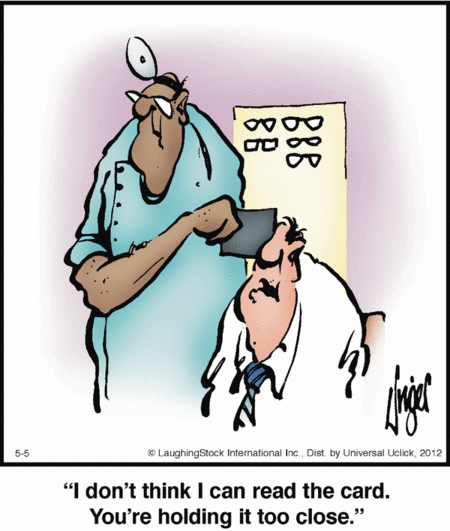Podcast: Play in new window | Download (Duration: 14:41 — 13.9MB)
Today’s audio is 14:41 minutes long.
 Vision. It’s something every elite athlete has. Observers consistently remark about a superstar athlete, “He’s got tremendous vision. He can see the field better than anybody.”
Vision. It’s something every elite athlete has. Observers consistently remark about a superstar athlete, “He’s got tremendous vision. He can see the field better than anybody.”
It’s not eye test kind of vision. It’s awareness. It’s seeing angles, possibilities and obstacles better and faster than others. And it gives elite athletes a major advantage.
At a car accident, somebody says, “I never saw him coming.”
When an employee is terminated or downsized, she may say, “I didn’t see it coming.”
Life presents us with many situations that catch us off guard and unaware. Are we stupid? No. Are we blind? Again, no. Sometimes we just don’t pay attention. Or we don’t pay close enough attention.
It’s been said of great leaders that they see the future first. That is, they can observe what’s happening and forecast the end result. Additionally, they can architect a plan giving them a glimpse of where that plan will lead. It’s not that they’re prophetic. They just see the end result of where the present course, or the planned course, will lead.
Parents do the same thing. Well, wise parents do. Our small child is walking by the edge of the pool. We sternly warn them to step back, to a safer distance away from the water. Why do we do that? Because we can see the future if they continue to prance around the edges of the swimming pool. Eventually, they’re going to fall in and have to be rescued. They’re a child. They can’t see what we see. They’ve not developed the awareness we have. That’s an act of parental leadership. It requires vision.
Your role and the roles of your direct reports also requires vision. The greater the vision, the greater the value you may bring to your company. The lower the vision, the lower your value. That makes this topic pretty important, don’t you think?
You can argue that technical competency trumps vision, but you’d be wrong.
A software programmer walks into the office of the manager to get direction on a project. The programmer is well versed in his craft. By all accounts he’s an excellent programmer skilled in multiple computer languages. And he’s fast. He’s able to tackle programming jobs that might take 25% longer for his peers. Or more. The manager, the executive in charge of development, has told me how remarkable this programmer’s technical skills are. “He’s the best I’ve ever had,” says the executive.
As the programmer enters the manager’s office, I see the manager bristle at his arrival. I don’t understand it. I’ve heard nothing but strong praise for this guy’s technical prowess. I sit silently and observe the conversation.
The programmer inquires about something to do with databases. It’s over my head. The manager seems flustered, but I’ve no idea why. He tells the programmer to do it a particular way. They banter back and forth with the programmer asking for clarification on a few points. Again, it’s over my head, but the questions seem appropriate and the programmer is respectful in his tone. It doesn’t last more than 5 minutes.
Then the manager turns to me and says, “He just can’t see it.”
“See what?” I ask.
“The bigger picture,” says the executive. “He just can’t see how everybody’s work fits together and how one thing may result in a problem elsewhere.”
The poor guy lacks vision. He can’t see the end result, or the consequences of actions.
 It’s not necessarily blindness. It’s certainly isn’t stupidity or ignorance. It’s awareness. How do you teach awareness?
It’s not necessarily blindness. It’s certainly isn’t stupidity or ignorance. It’s awareness. How do you teach awareness?
Let’s take a lesson from sports. If you’re not a sports fan, don’t fret about it. You’ll still understand better by hearing this analogy.
You’ve likely heard me talk of two terms that have to do with closely examining work and process: triage and post-mortem.
Triage happens before we take action. That’s what emergency room doctors must do whenever they’re overrun with more patients than they can comfortably handle. They examine each patient upon arrival so they can determine which patients have the most dire needs. Then, they handle those patients first. It doesn’t mean they never get around to the other patients. It just means those patients with life threatening conditions get to go first. The rest, wait.
A post-mortem occurs at the other end, the finish. That’s when we examine what happened after it’s all over. As I use the term, it can be a positive result or a negative result. In the medical world, a post-mortem occurs “after death,” which is what the term literally means. Medical examiners do it to determine the cause of death. In our businesses, we do it to determine the cause of the success, or the cause of the failure. It’s an examination of things after-the-fact so we can learn. That’s how I use the term.
Professional sports teams do these activities as well as anybody. Well, to be fair, they do it as well as anybody the way I’m using these terms. Medical examiners and doctors likely do it better than anybody.
Take a professional football team. I’m in Dallas so we’ll use the Dallas Cowboys. But other than a meddling owner, I’m rather sure all the other NFL teams do similar things.
Triage happens when the Cowboys go draft players fresh out of college, or when they sign free agent talent, or when they make a trade with another team. They closely examine the player to determine how they believe he can help them improve their record. They’re looking him over to determine if he can help and how he can help. They’re also considering how much he’ll cost them. Unlike other enterprises, they’ve got a salary cap which helps the owners predict their profits more accurately. They can only spend a certain amount of money for their entire roster. So the money matters.
They have an element that may not exist where you work. It’s called video. For years they’ve had video. It went from film to tape to digital files. It’s been around for a very long time. Camera people hired by the teams to shoot practices and games so they can examine what they’re doing and so other teams can see what they’re doing. In fact, even at the high school football level schools exchange video with each other prior to playing one another. So do the college and pro teams. There are rules about such things. Can you imagine having to supply your rival, a competitor, with video that shows exactly what you do when you play?
The Cowboys can go look at hours and hours of film to watch the specific player they’re interested in. After all this triaging is done to see if they think this player can help them, they move forward to try to sign him to a contract. Again, they have 3 avenues to take to get a player. The draft, where a player comes out of college. Free agency, where a player has played long enough in the league to test the market and see how many teams may want him and to see how much they’ll pay. A trade, where Dallas has to give up some players in return for getting a player away from another team. But all this effort to try to see the future first has to happen in advance. Triage.
That same video used to triage acquiring a player is now used in post-mortems. After each game the team watches the video with coaches dissecting plays to point out what the team (and individual players) did well and where they failed. Post-mortem.
Awareness in your professional life and among your direct reports will greatly determine the outcome.
In sports, good coaches sometimes are fired because of the poor performance of the players. Proof that your own awareness, and the awareness of your team can impact not just the organization, but YOUR career.
Just like a driver who gets in a wreck because “I didn’t see him” so too can you wreck your career with your own lack of vision.
During a short coaching session like this I don’t have time to discuss all the ways or the areas where our vision impacts our life, but I want to give you some ideas you can take to work on these things on your own. I hope you’ll give it the time and attention it deserves because frankly, there are few things you could do to help yourself and your team more. I want to encourage you to triage and post-mortem various areas of your work so you can help yourself and your team improve.
- What’s the purpose of your team? Why are you guys doing what you do, together?
- How do you guys work together? Not merely in a word – “well” or “poorly” – but detailed out. Dissect it. If there are problems, find them. If there are people, like the programmer, who create problems, identify those problems.
- How do you guys manage the chain of command? Again, dissect it. This means how well the team manages up the chain and down the chain – and along the chain of their peers?
- How well does the team see the future first? Are all members of the team able to see what the parent of the toddler at the edge of the pool sees?
When you go to the trouble to properly triage the work and your people’s responsibility to the work, you’ll produce better results.
When you go to the trouble to dissect (post-mortem) the work and your people’s contributions to the work, you’ll learn how to perform at a higher level.
You can’t improve on what you can’t see. It’s true for everybody in every field or endeavor. Vision makes a difference. First, you gotta see it. So start looking and examining more closely.
